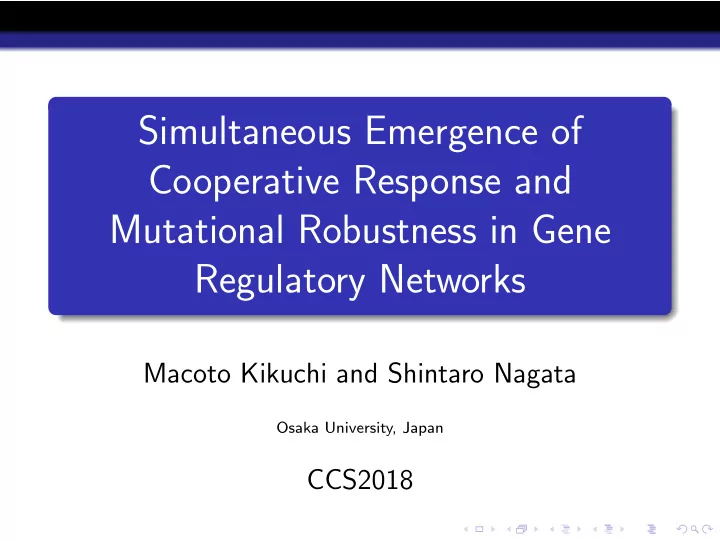

Simultaneous Emergence of Cooperative Response and Mutational Robustness in Gene Regulatory Networks Macoto Kikuchi and Shintaro Nagata Osaka University, Japan CCS2018
Motivation Living systems exhibit high fitness and robustnesses simultaneously. Robustness against mutation Robustness against noise These robustnesses have been aquired through evolution. The evolution is considered as something special Problem Relationship between evolution and robustnesses
We study a simple model of the gene regulatory network without using evolutionary simulations make an ensemble of GRNs with high fitness by Multi-canonical MC To explore the universal properties of highly fitted GRNs. The robustnesses in particular.
The gene regulatory network The cell state is regulated by the expression levels of many genes adaptively to the environmental conditions. Gene expressions are regulated by the transcription factors (TF), which themselves are proteins produced from genes. Genes are mutually regulated through TF
Gene regulation GRN
Model Directed random graph with N nodes and K edges Node: Gene Edge: Regulatory relation 1 input gene and 1 output gene Average number of edges connected to a node is 2 K / N = 5
Discrete-time dinamics S i ( t + 1) = R ( σδ i , 1 + Σ j J ij S j ( t )) R ( x ) = tanh x + 1 2 S i : Expression of i th gene (continuus variable of [0 , 1)) J ij : Interaction from j th to i th gene J ij = ± 1 (activation or repression) or 0 (no regulation) σ : Input signal from outside
1.0 Response function 0.8 0.6 R each gene 0.4 respond 0.2 moderately 0.0 −4 −2 0 2 4 S i
Effective response Consider the steady state Effective response of i th gene against the input σ τ + T S i [ σ ] ≡ 1 ¯ ∑ S i ( t ) T t = τ Fitness Sensitivity of gene i ∆ i = | ¯ S i [1] − ¯ S i [0] | Fitness f ≡ max { ∆ i }
Method Rare event sampling by the Multicanonical ensemble Monte Carlo method regarding the fitness f as energy It ebables us to sample GRNs in a wide range of fitness randomly (in principle). Wang-Landau method for determining the Monte Carlo weight
Fitness Landscape N=32 K=80 10 −2 N=28 K=70 N=24 K=60 N=20 K=50 10 −5 N=16 K=40 10 −8 P(f) 10 −11 10 −14 10 −17 10 −20 0.0 0.2 0.4 0.6 0.8 1.0 f Probability distribution of the fitness
̄ ̄ Steady-State Response Response for f ≃ 0.7( N = 32, K = 80) Response for f ≃ 1 ( N = 32, K = 80) 1.0 1.0 0.8 0.8 0.6 0.6 S out ( σ ) S out ( σ ) 0.4 0.4 0.2 0.2 0.0 0.0 0.2 0.4 0.6 0.8 1.0 0.0 0.2 0.4 0.6 0.8 1.0 σ σ f ≃ 0 . 7 f ≃ 1
Emergence of fixed-point switching For f ≃ 1, all the networks have two fixed points Emergence of the cooperative response to the input using the fixed point switching mechanism A kind of inovation takes place inevitably for highly fitted GRNs. Question Then, can they respond properly to the rapid change of input?
Dynamical Response Response to abruptly changing input 1.0 1.0 0.8 0.8 Response Response 0.6 0.6 0.4 0.4 0.2 0.2 0.0 0.0 0 100 200 300 400 500 600 0 100 200 300 400 500 600 Time Time Some GRNs can follow, Some cannot
Effect of Internal Noise Consider the number flucturations of TFs as the internal noise. S i ( t ) → S i ( t ) + r i r i : uniform random number in [ − 0 . 1 , 0 . 1]
1.0 1.0 0.8 0.8 Response 0.6 Response without fluctuation 0.6 with fluctuation without fluctuation 0.4 with fluctuation 0.4 0.2 0.2 0.0 0 100 200 300 400 500 600 0.0 Time 0 100 200 300 400 500 600 Time Robust against internal Noise-induced response noise
w/o noise: ∼ 60% of GRNs can respond sensitively They are robust against internal noise w noise: ∼ 74% of GRNs can respond sensitively Noise-Induced sensitive response Internal noise makes GRNs to respond properly
Robustness against mutation N = 32, K = 80 Consider f = 0.99 0.40 0.9 0.8 single-edge 0.35 0.7 0.6 0.30 0.5 deletion 0.25 P ( f * ) 0.20 A moderate 0.15 0.10 mutation 0.05 0.00 All the possible 0.0 0.2 0.4 0.6 0.8 1.0 f * cuts are tried Fitness after mutation
f = 0.99 Majority of edges N=32 K=96 N=32 K=90 0.4 are neutral 0.3 P ( f * ) Small number of 0.2 edges are lethal 0.1 No intermediate 0.0 0.0 0.2 0.4 0.6 0.8 1.0 f * edge For f ≃ 1
2 K / N = 5 N=16 0.10 20 24 28 Small number of 0.08 32 0.06 lethal edges P ( n ) 0.04 The peak is 0.02 independent of N 0.00 0 20 40 60 80 100 n Larger GRNs are Number distribution of relatively robust lethal edges
Summary Result For the GRNs with high fitness, we found that the majority of the networks own the following robustnesses Mutational Robustness 1 Robustness against internal noise 2 Robustness against input noise (not shown) 3 Proposal These robustnesses are not the consequence of the evolution, but the characteristic properties accompanying to the high fitness irrespective to the pathway of evolution
Rubustness ageinst input noise input 1.25 output 1.00 0.75 S out 0.50 0.25 0.00 −0.25 0 1000 2000 3000 4000 5000 6000 7000 8000 9000 t Response to a noisy input
Recommend
More recommend